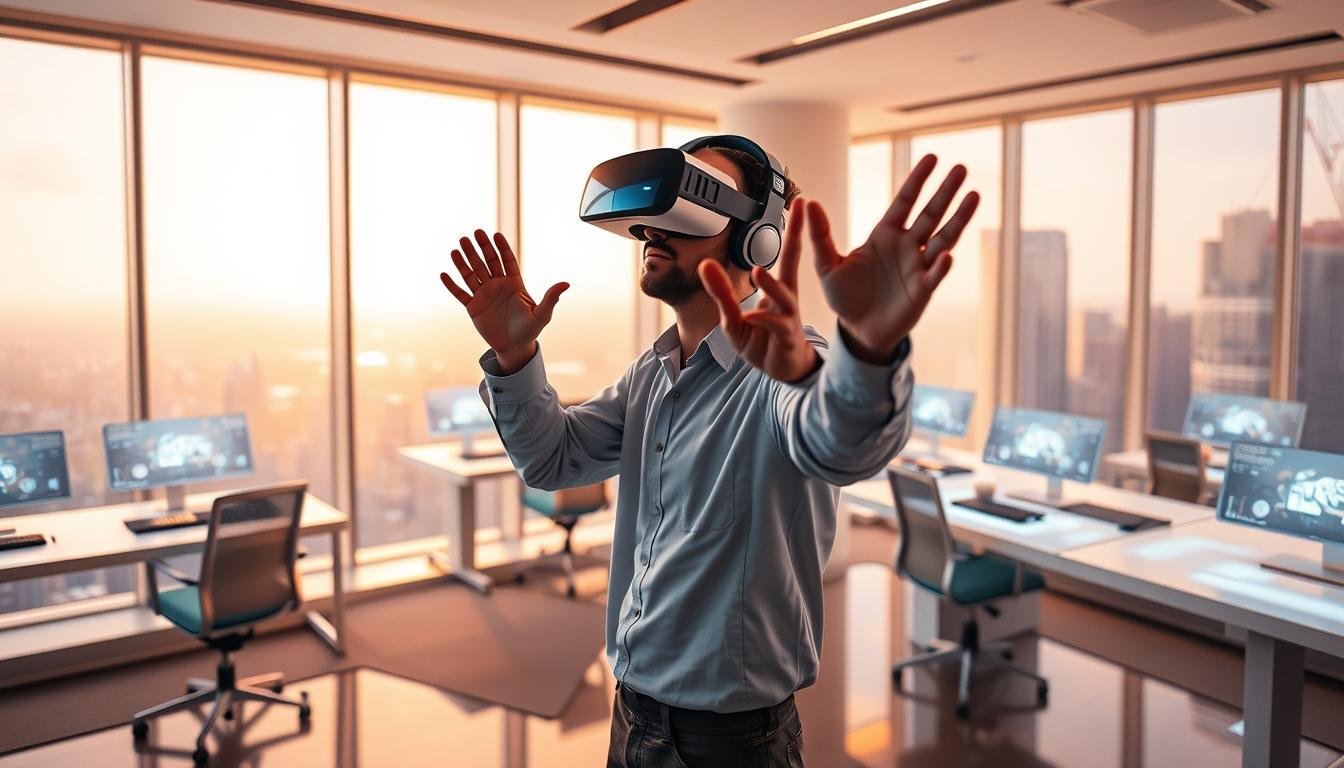Imagine stepping into a meeting room where your colleagues from across the globe gather seamlessly, despite being miles apart. This is no longer a futuristic dream but a reality powered by virtual reality. From collaborative workspaces to immersive social interactions, this technology is reshaping how we connect and collaborate.
Businesses are increasingly adopting virtual reality to bridge physical distances and foster real-time collaboration. Remote teams can now interact in shared digital environments, enhancing productivity and creativity. This blend of physical and digital experiences is revolutionising traditional work models.
Beyond the workspace, virtual reality is also transforming social interactions. Whether it’s attending virtual events or exploring shared digital spaces, this technology is creating new ways to connect. The possibilities are endless, and the impact is profound.
Key Takeaways
- Virtual reality is revolutionising workspaces by enabling seamless remote collaboration.
- Businesses are integrating this technology to enhance productivity and creativity.
- It blends physical and digital experiences, offering immersive interactions.
- Social connections are being redefined through virtual events and shared spaces.
- The transformative impact of this technology is reshaping both work and social environments.
Introduction to VR in Modern Work and Social Life
Once confined to entertainment, virtual reality now plays a pivotal role in modern workplaces and social interactions. This technology has evolved from a niche innovation to a mainstream tool, transforming how we connect and collaborate.
At the heart of this transformation are VR headsets and immersive platforms. These tools create virtual environments where employees and learners can interact seamlessly. Whether it’s a team meeting or a training session, the experience feels real and engaging.
Beyond gaming, virtual reality has found practical applications in the corporate world. Businesses use it to enhance productivity, streamline processes, and foster creativity. For example, immersive simulations allow employees to practice skills in a safe, controlled environment.
This technology is also redefining social interactions. Virtual events and shared digital spaces offer new ways to connect with others. Whether it’s attending a conference or exploring a virtual gallery, the possibilities are endless.
As highlighted in a recent study, virtual reality’s potential extends far beyond entertainment. It’s becoming a cornerstone of modern work and social life, offering immersive experiences that bridge physical and digital worlds.
How VR is Changing the Way We Work
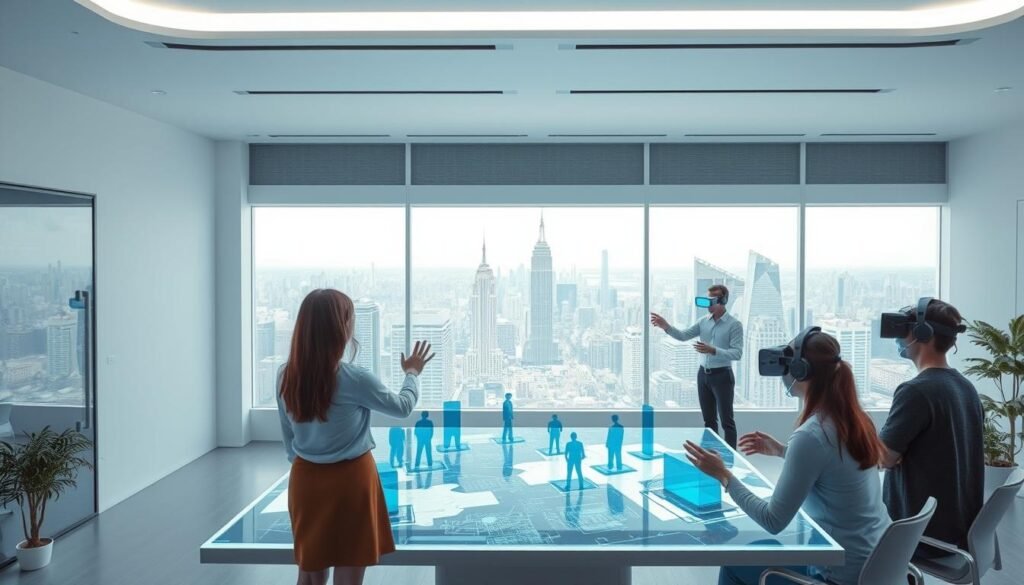
The modern workplace is undergoing a transformation, with virtual reality at its core. This technology is not just a tool for entertainment but a game-changer for businesses and teams worldwide. It’s redefining how we approach remote work and office collaboration, making distance irrelevant.
Embracing Remote Work with VR
Remote work has become a staple of modern life, and virtual reality is maximising its efficiency. Imagine attending a meeting where you feel physically present, even if your colleagues are miles away. Platforms like Meta’s Horizon Workrooms create lifelike meeting spaces, enhancing interaction and productivity.
These immersive environments bridge the gap between physical and digital workspaces. They allow teams to collaborate in real-time, fostering creativity and maintaining team spirit. The benefit is clear: geographical barriers no longer hinder effective teamwork.
Revolutionising Office Collaboration
Traditional office collaboration is also being transformed. Companies are using virtual reality to create shared digital spaces where employees can brainstorm and innovate. For instance, Meta’s tools enable teams to visualise projects in 3D, streamlining the design process.
This approach is not only cost-effective but also boosts productivity. Employees can practice skills in simulated environments, reducing risks and improving outcomes. The role of this technology in modern workplaces is undeniable, offering new ways to enhance daily work experiences.
As businesses continue to adopt these solutions, the future of work looks more connected and immersive than ever. The possibilities are endless, and the impact is profound.
The Evolution of Virtual Reality in the Workplace
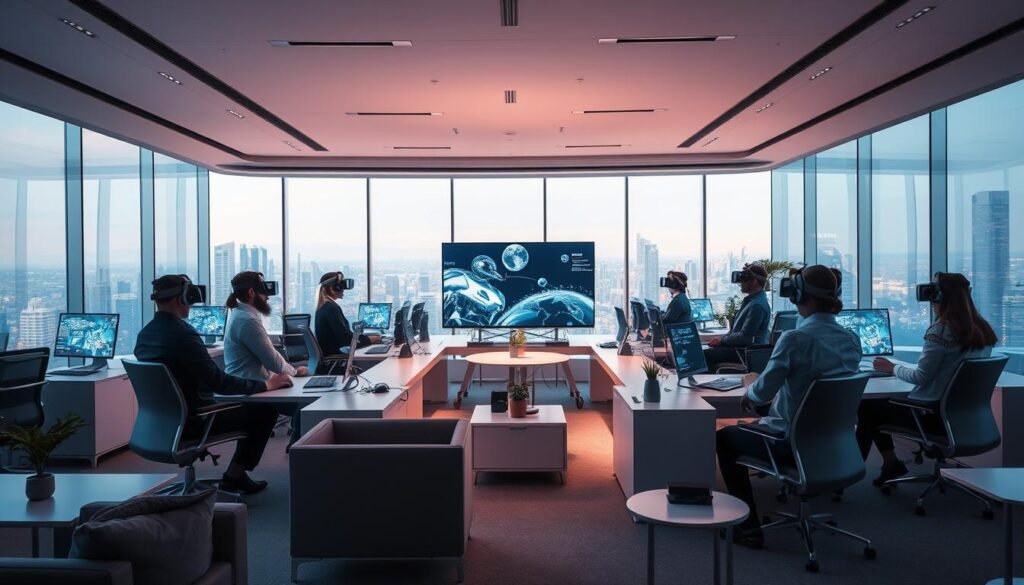
The workplace is evolving rapidly, with virtual reality leading the charge in digital transformation. This technology is no longer a futuristic concept but a practical tool reshaping how businesses operate. From flexible hybrid models to immersive digital spaces, the application of virtual reality is transforming traditional work environments.
Digital Transformation and Hybrid Work
Hybrid work models are becoming the norm, and virtual reality is at the forefront of this shift. Companies are leveraging this technology to create seamless transitions between physical and digital workspaces. For instance, employees can now attend meetings in immersive environments, fostering collaboration regardless of location.
This approach not only enhances productivity but also supports work-life balance. By integrating virtual reality, businesses can offer flexible solutions that cater to modern workforce needs. The result is a more engaged and efficient team.
Adapting to New Work Environments
Adapting to new work environments is essential for staying competitive. Virtual reality provides the tools to create dynamic and interactive spaces. For example, industries like healthcare and education are using this technology to simulate real-world scenarios, improving skills and knowledge retention.
Students and professionals alike benefit from these immersive experiences. They can practice complex tasks in a safe environment, gaining confidence and expertise. This innovative approach is redefining how we learn and work.
“Virtual reality is not just a tool; it’s a gateway to new possibilities in the workplace.”
As highlighted in a recent study, the adoption of virtual reality is scaling across various sectors. From manufacturing to retail, businesses are using this technology to streamline workflows and foster innovation. The future of work is here, and it’s more connected than ever.
Enhancing Communication and Collaboration with VR
Virtual reality is redefining how you communicate and collaborate in professional settings. This technology offers immersive solutions that bridge physical distances, making interactions feel natural and engaging. Whether you’re attending a meeting or participating in a global event, the experience is transformative.
Virtual Meetings and Event Experiences
Imagine stepping into a virtual meeting room where your colleagues appear as lifelike avatars. Platforms like Meta Horizon Workrooms create spaces that mimic physical environments, fostering a sense of presence. This approach enhances communication, making it easier to share ideas and collaborate effectively.
Event experiences have also evolved. Global teams can now interact without the need for travel. Virtual conferences, workshops, and networking events offer opportunities to connect and learn in real-time. This not only saves time but also reduces costs, making it a practical solution for modern businesses.
The person-centred benefits of this technology are significant. Each user experiences a customised environment tailored to their needs. This level of personalisation enhances engagement and ensures that everyone feels included, regardless of their location.
Innovative solutions are setting the future of digital communication. Industries like healthcare, education, and manufacturing are adopting these tools to streamline workflows and improve outcomes. The potential is vast, and the impact is already being felt across major sectors.
| Benefit | Description |
|---|---|
| Natural Communication | Engage with colleagues in lifelike virtual meeting rooms. |
| Global Collaboration | Interact with teams worldwide without travel. |
| Personalised Experience | Customised environments tailored to individual needs. |
| Time Efficiency | Save time by attending virtual events and meetings. |
As highlighted in a recent study, virtual reality is transforming workplace communication. It fosters a sense of community among distributed teams, enhancing productivity and engagement. The future of collaboration is here, and it’s more connected than ever.
Immersive Training and Skill Development
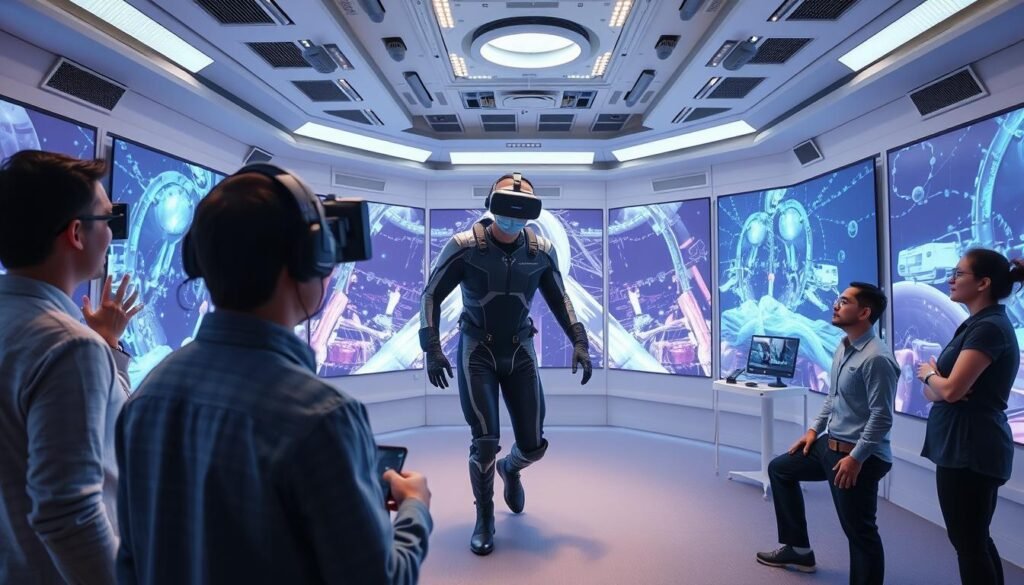
Immersive learning is revolutionising professional development, offering hands-on experiences in simulated environments. This approach is transforming how skills are acquired and applied, making it a cornerstone of modern education.
Simulated Learning Environments
Simulated learning environments provide a safe space for practical training. For instance, the Johnson & Johnson Institute uses virtual reality to train surgeons in lifelike scenarios. This method enhances retention and reduces risks, ensuring skills are mastered before real-world application.
These environments are particularly effective in fields requiring precision and practice. By replicating real-world challenges, they prepare professionals for complex tasks, boosting confidence and competence.
Onboarding and Professional Development
Onboarding processes are also being redefined through immersive experiences. Companies are using virtual reality to introduce new employees to their culture and workflows. This interactive approach accelerates integration and fosters a sense of belonging.
Professional development programmes benefit from this technology as well. Employees can engage in continuous learning, exploring new skills in a dynamic space. This not only enhances their capabilities but also keeps them motivated and engaged.
“Immersive training bridges the gap between theory and practice, offering a transformative learning experience.”
As highlighted in a recent study, immersive corporate training is setting new standards in skill acquisition. It combines theoretical knowledge with practical simulation, creating a comprehensive learning experience. The future of education and professional growth is here, and it’s more engaging than ever.
Revolutionising Design and Creative Processes
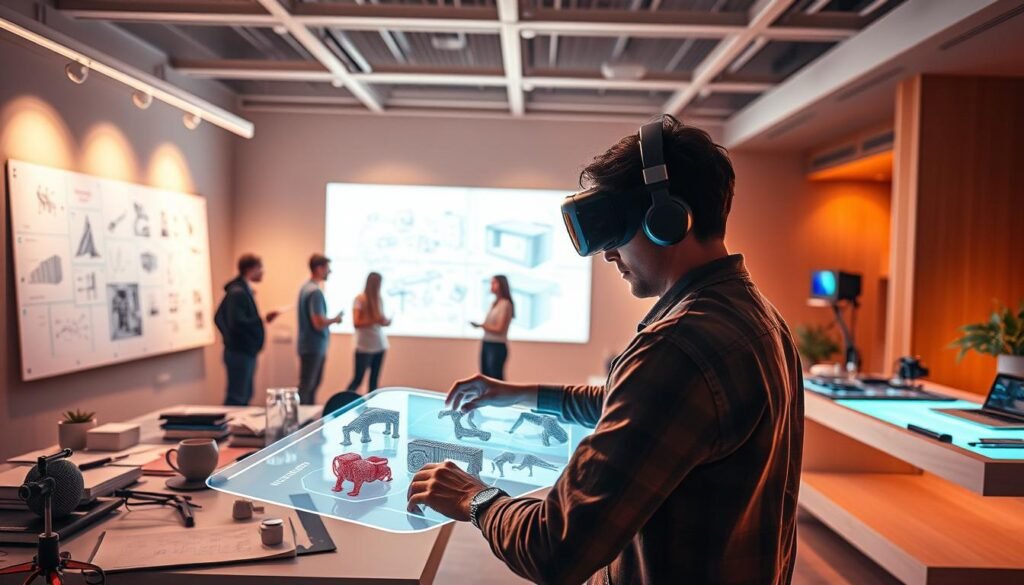
The creative landscape is being transformed by immersive tools that bring ideas to life in three dimensions. These technologies are enabling design teams to collaborate and innovate in ways that were once unimaginable. By blending physical and digital experiences, they are redefining the creative process.
3D Modelling and Prototyping
One of the most significant advancements is the use of immersive tools for 3D modelling and prototyping. Platforms like Gravity Sketch on Meta Quest allow teams to create and refine designs in real-time. This approach enhances the ability to visualise complex ideas and iterate rapidly, saving time and resources.
For example, a design team can sketch a concept in a virtual space, tweak it collaboratively, and produce a prototype within hours. This level of efficiency was previously unattainable with traditional methods. The result is a more dynamic and interactive creative workflow.
These tools also improve communication among teams. By working in shared virtual environments, members can provide instant feedback and refine ideas collectively. This fosters a culture of innovation and ensures that everyone’s input is valued.
“Immersive tools are not just enhancing creativity; they are redefining how we approach design and collaboration.”
Adopting these solutions transforms traditional workflows into dynamic creative spaces. The ability to capture intricate details and experiment freely empowers designers to push boundaries and achieve groundbreaking results.
VR in Business: Real-World Applications and Use Cases
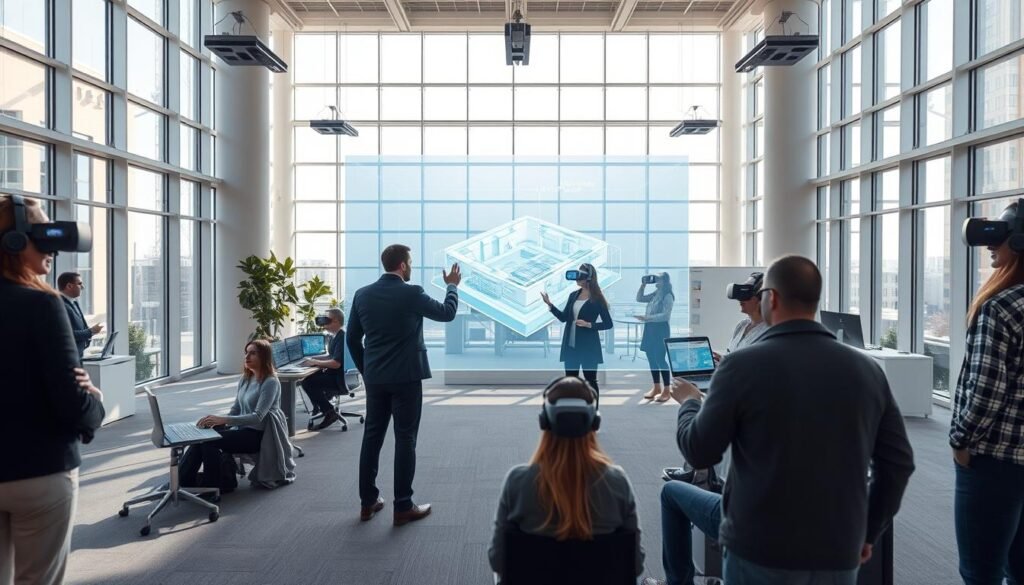
Businesses across sectors are leveraging immersive technology to tackle real-world challenges. From retail to healthcare, companies are adopting innovative solutions to enhance operations and customer experiences. These applications are not just futuristic concepts but practical tools delivering measurable results.
One example is IKEA’s VR kitchen experience, which has transformed customer engagement. By allowing users to visualise their dream kitchens, the brand has reduced return rates and increased satisfaction. This new way of shopping bridges the gap between online and in-store experiences.
In the retail sector, Sephora’s Virtual Artist app is another example of innovation. The app lets customers try on makeup virtually, boosting online sales and improving user confidence. These tools are redefining how brands interact with their audiences.
Case Studies Across Industries
Walmart has embraced immersive technology for employee training. Their VR programmes have improved staff performance and reduced training costs. This approach ensures employees are better prepared for real-world scenarios, enhancing productivity and efficiency.
In healthcare, immersive simulations are revolutionising nursing education. Students can practice real-world scenarios in a risk-free environment, improving their readiness for patient care. This new way of learning ensures higher retention and competency.
Tommy Hilfiger’s virtual fashion shows are a standout example in the fashion industry. These events have enhanced brand visibility and attracted a younger, tech-savvy audience. By adopting immersive tools, the brand has stayed ahead of the curve.
These case studies highlight the strategic importance of immersive technology in business. Whether it’s streamlining processes or enhancing customer interactions, the applications are vast and impactful. Companies that integrate these solutions are setting new standards in their industries.
Benefits of VR for Employee Well-being and Stress Reduction

In today’s fast-paced digital environment, finding ways to unwind and recharge is essential for maintaining productivity. Prolonged screen time and digital fatigue are common challenges, but immersive technology offers a solution. By stepping into a virtual world, employees can escape routine pressures and rejuvenate their minds.
Reducing Digital Burnout
Digital burnout is a growing concern, with studies showing that excessive screen time can reduce productivity by up to 40%. Immersive technology provides a unique way to combat this. Employees can engage in relaxing activities within a virtual space, such as guided meditation or virtual nature walks. These experiences help reduce stress and improve mental clarity.
For example, companies like Calm and Headspace have introduced immersive programmes specifically designed to ease employee stress. These tools create a virtual world where users can disconnect from work and focus on their well-being. The result is a more balanced and motivated workforce.
Here are some key benefits of using immersive technology for employee well-being:
- Provides a break from prolonged screen exposure, reducing eye strain and fatigue.
- Offers a virtual space for relaxation, helping employees recharge mentally.
- Enhances mental health by promoting mindfulness and stress relief.
- Improves overall job satisfaction and performance.
One notable case is Google’s use of immersive technology in their wellness programmes. Employees can participate in virtual yoga sessions or explore calming environments, fostering a healthier work culture. This approach has been shown to reduce burnout and increase engagement.
“Immersive technology is not just a tool for work; it’s a gateway to better mental health and well-being.”
As highlighted in a recent study, employees who engage in stress-relief activities are 30% less likely to experience burnout. By integrating immersive solutions, companies can create a supportive environment that prioritises employee health. The future of workplace well-being is here, and it’s more immersive than ever.
The Future of VR in the Corporate Metaverse
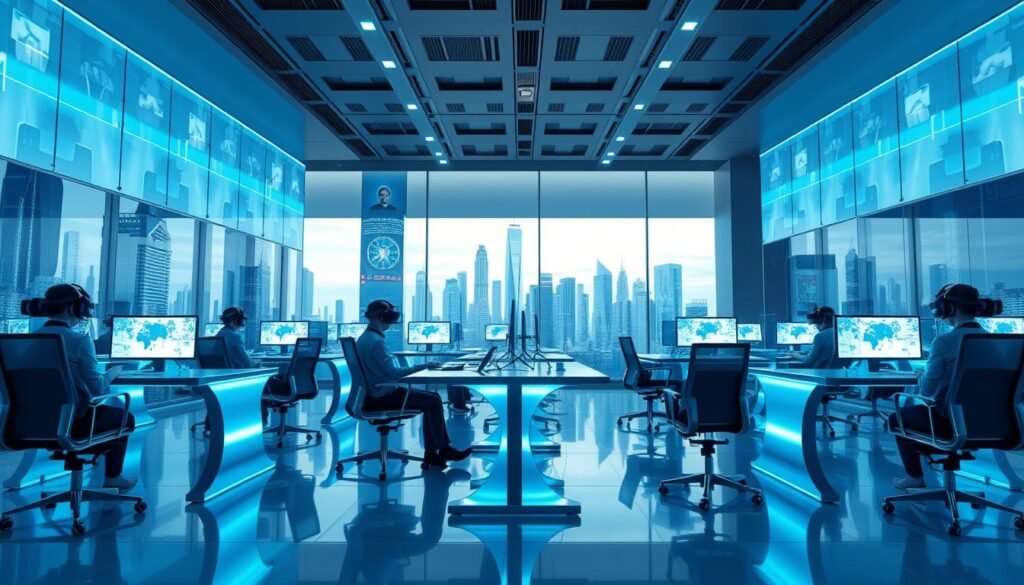
The corporate metaverse is poised to redefine how businesses operate, offering unprecedented levels of immersion and collaboration. As industries embrace digital transformation, this technology is set to revolutionise workflows and foster innovation. The integration of virtual environments into corporate processes is no longer a distant dream but a tangible reality.
Innovation and Investment Forecasts
Investment in the corporate metaverse is skyrocketing, with forecasts predicting significant growth across industries. Companies are allocating substantial budgets to adopt immersive technologies, recognising their potential to enhance productivity and streamline operations. For instance, McKinsey highlights that organisations are already implementing Generative AI and digital twins, paving the way for cost-effective solutions.
These innovations are not just about technology; they’re about creating value. By leveraging advanced simulation capabilities, businesses can model complex scenarios and make informed decisions. This approach reduces risks and accelerates deployment, offering a competitive edge in today’s fast-paced market.
Emerging Trends in VR Technology
Emerging trends in VR technology are pushing the boundaries of what’s possible. Enhanced simulation tools are enabling businesses to create lifelike environments for training, design, and collaboration. For example, Unity’s Universal Render Pipeline is enhancing visual performance, making virtual experiences more realistic and engaging.
Another trend is the integration of AI and machine learning into VR platforms. This combination allows for personalised and responsive experiences, aligning with industry demands for automation and customisation. As highlighted by Gartner, these advancements are driving the adoption of immersive technologies across sectors.
| Trend | Impact |
|---|---|
| Advanced Simulations | Improves training and decision-making processes. |
| AI Integration | Enables personalised and responsive experiences. |
| Investment Growth | Drives adoption and innovation across industries. |
The long-term impact of these trends is profound. Businesses that adopt these technologies early will gain a significant advantage, transforming how they operate and interact with their stakeholders. The corporate metaverse is not just a trend; it’s the future of work.
Ethical Considerations and Social Impact of VR
As immersive technology advances, ethical considerations and social impact take centre stage. This technology is not just a tool for innovation but a force shaping how we interact and understand one another. From fostering empathy to promoting digital inclusion, its influence is profound.
Enhanced Empathy and Social Awareness
Immersive experiences have the power to foster empathy by placing users in others’ shoes. Initiatives like Meta’s ‘VR for Good’ programme create scenarios that highlight social challenges, encouraging deeper understanding. For example, a computer-generated simulation of dyslexia helps non-dyslexic individuals grasp the daily struggles faced by those with the condition.
These experiences go beyond traditional learning methods. They offer a review of societal issues through a lens of compassion, making abstract problems tangible. By engaging with these virtual environments, users develop a heightened sense of social awareness.
Digital Inclusion and Accessibility
Virtual reality also presents an opportunity to bridge gaps in accessibility. For individuals with disabilities, immersive tools can create inclusive spaces for education and community engagement. Projects like the VRAIlexia initiative use computer-based simulations to support university students with dyslexia, offering tailored learning solutions.
This technology is not just about accessibility; it’s about empowerment. By leveraging computer-generated environments, organisations can ensure that everyone has the chance to participate fully in society. The potential for positive change is immense.
“Immersive technology is a gateway to understanding and inclusion, offering transformative experiences that challenge traditional norms.”
| Aspect | Impact |
|---|---|
| Empathy Building | Encourages compassion through immersive experiences. |
| Accessibility | Creates inclusive spaces for education and engagement. |
| Social Awareness | Highlights societal issues in a tangible way. |
As we review the ethical implications of this technology, it’s clear that its potential extends far beyond entertainment. It’s a tool for fostering empathy, promoting inclusion, and driving social change. The opportunity to create a more compassionate and accessible world is within reach.
Navigating VR Technology and Headset Reviews
Choosing the right VR headset can feel overwhelming, but understanding key technical specifications simplifies the process. With so many options available, it’s essential to evaluate performance, compatibility, and long-term value. This guide will help you navigate the complex world of immersive technology, offering practical insights for businesses and individuals alike.
Technical Specifications and Performance
When selecting a VR headset, technical specifications play a crucial role. For instance, the Meta Quest 3S boasts a resolution of 1,832 x 1,920 pixels per eye and a refresh rate of 90-120 Hz. These features ensure smooth visuals and reduce motion sickness, making it a popular choice for both gaming and professional use.
Another standout product is the PlayStation VR2, with a resolution of 2,000 x 2,040 pixels per eye and a wider field of view at 110 degrees. This headset is ideal for immersive experiences, though it requires a PS5 for optimal performance. Understanding these metrics helps you choose the right tool for your needs.
Evaluating VR Headsets for Business Use
For businesses, selecting the right VR headset involves more than just technical specs. Compatibility with existing systems and ease of integration are equally important. The Meta Quest 3S, for example, is a standalone device that doesn’t require additional hardware, making it a cost-effective solution for companies.
On the other hand, the PlayStation VR2 offers advanced features but is tied to the PS5 ecosystem. This makes it suitable for companies already using Sony’s technology. Evaluating these factors ensures you invest in a product that aligns with your organisational goals.
Practical Advice for Integration
Integrating VR technology into your workflow requires careful planning. Start by identifying the specific tasks the tool will address, such as training or design. Then, ensure your team is trained to use the technology effectively.
For example, many companies use VR for immersive training programmes. The Meta Quest 3S’s lightweight design and high-resolution display make it ideal for such applications. By aligning the product with your needs, you can maximise its value and enhance productivity.
“The right VR headset can transform how your business operates, offering immersive solutions that drive innovation and efficiency.”
By understanding technical specifications and evaluating performance, you can make an informed decision. Whether you’re a small company or a large enterprise, the right VR tool can revolutionise your workflow.
Integrating VR into Your Everyday Work Life
Transforming your daily work routine with immersive tools is now easier than ever. These technologies are no longer reserved for niche applications but are becoming essential for enhancing productivity and collaboration. By adopting the right strategies, you can seamlessly integrate these solutions into your organisation.
Adopting VR Tools in Your Organisation
Start by identifying areas where immersive tools can add value. For example, learning and development programmes benefit greatly from virtual simulations. Companies like Johnson & Johnson have successfully implemented global training programmes using this model, improving skill retention and reducing costs.
Next, ensure your team has access to the necessary hardware and software. Platforms like Meta’s Horizon Workrooms offer user-friendly interfaces, making the transition smoother. Providing adequate training ensures everyone can leverage these tools effectively.
Maximising Productivity with VR
Immersive tools can streamline workflows and enhance communication. For instance, virtual meetings eliminate the need for travel, saving time and resources. Teams can collaborate in shared digital spaces, fostering creativity and innovation.
Consider the impact on employee health and well-being. Prolonged screen time can lead to digital fatigue, but immersive environments offer a refreshing alternative. Guided meditation or virtual nature walks can help employees recharge, boosting overall productivity.
“Integrating immersive tools into your workflow isn’t just about technology; it’s about creating a more connected and efficient workplace.”
Here’s a step-by-step guide to get started:
- Assess your organisation’s needs and identify key areas for improvement.
- Invest in the right hardware and software, ensuring compatibility with existing systems.
- Train your team to use these tools effectively, focusing on practical applications.
- Monitor progress and gather feedback to refine your approach.
By following these steps, you can unlock the full potential of immersive tools, transforming how your team works and collaborates. The future of work is here, and it’s more connected than ever.
Conclusion
The integration of immersive technology into daily workflows is no longer a distant idea but a present reality. From enhancing team meetings to streamlining complex tasks, its applications are vast and impactful. Real-world use cases demonstrate how this technology reshapes collaboration and productivity, offering measurable benefits.
Staying ahead of emerging trends is crucial. Investing in these tools not only boosts efficiency but also fosters innovation. The datum shared throughout this article highlights the transformative potential of adopting such solutions.
Explore the opportunities this technology presents. Whether it’s improving communication or redefining creative processes, the benefits are undeniable. Embracing these advancements is not just beneficial—it’s inevitable in today’s evolving digital landscape.
FAQ
How does virtual reality enhance remote work?
What role does VR play in office collaboration?
Can VR improve training and skill development?
How is VR used in design and creative processes?
What are some real-world applications of VR in business?
How does VR benefit employee well-being?
What does the future hold for VR in the workplace?
Are there ethical concerns with VR technology?
What should you consider when choosing a VR headset?
How can you integrate VR into your daily work life?
Source Links
- The Metaverse Explained: How This Virtual World Is Shaping Our Future
- Why Immersive Technology is a Key Prospect for Innovation – New York Weekly
- Armor to the Expanding Virtual Universe: A Mental Health Monitoring System Addressing Escapism And…
- Classes
- What the Amazon Can’t Deliver: Lessons Learned from Virtual Reality-Based Sustainability Education
- Virtual Reality Applications in the Real World
- Virtual Reality Training is Revolutionizing Construction Safety
- From VR headsets to 360-degree assessments, how to build the lacking soft skills of students
- Immersive technologies in aerospace: From innovation to necessity
- XReadyLab.com | Best VR education | Free 3D models | Science | Tools for teachers | VR classroom How VR Can Enhance Critical Thinking and Creativity in STEM %
- Exploring the Applications of Virtual Reality in Medical Training
- Creativo: Design and Evaluation of a Multi-user Collaborative Learning Environment in Virtual Reality
- J. J. Keller Launches Virtual Reality Safety & Compliance Training
- Immersive learning: FSU College of Social Work to Launch AI-powered Tool to Enhance Child Welfare Education
- XReadyLab.com | Best VR education | Free 3D models | Science | Tools for teachers | VR classroom The Intersection of VR and AI in the Future of School Education %
- How Mixed Reality Technology is Revolutionizing Remote Development
- How VR is Transforming the Retail and Shopping Experience – Iexor
- LMS for Virtual Reality Learning: How VR Transforms Online Training
- How VR & Gamification Are Transforming Nursing Education
- The “Digital Fatigue” Epidemic: How Over-Tooling Kills Employee Productivity
- Top Airlines Innovating with Virtual Reality in the Sky
- The irresistible marriage of AI and XR | Computer Weekly
- Are We Ready for the Metaverse? Implications, Legal Landscape, and Recommendations for Responsible Development – Digital Society
- Unity’s Role in Shaping the AR/VR Landscape: A Post-Apple Evolution
- Fostering Inclusion: A Virtual Reality Experience to Raise Awareness of Dyslexia-Related Barriers in University Settings
- Immersive environment and neurogaming: a look at the impacts on humans and fundamental rights in the new frontiers arising from technology – AI and Ethics
- Will VR headsets one day replace physical screens?
- The Best Budget VR Headsets – IGN
- Parent’s guide to VR headsets and VR games for kids
- Virtual Reality in Healthcare: Transforming Medicines
- How Text-to-Speech Technology is Revolutionizing Employee Training and Engagement in the Workplace
- Harnessing the Power of AI 3D Model Generator Technology
